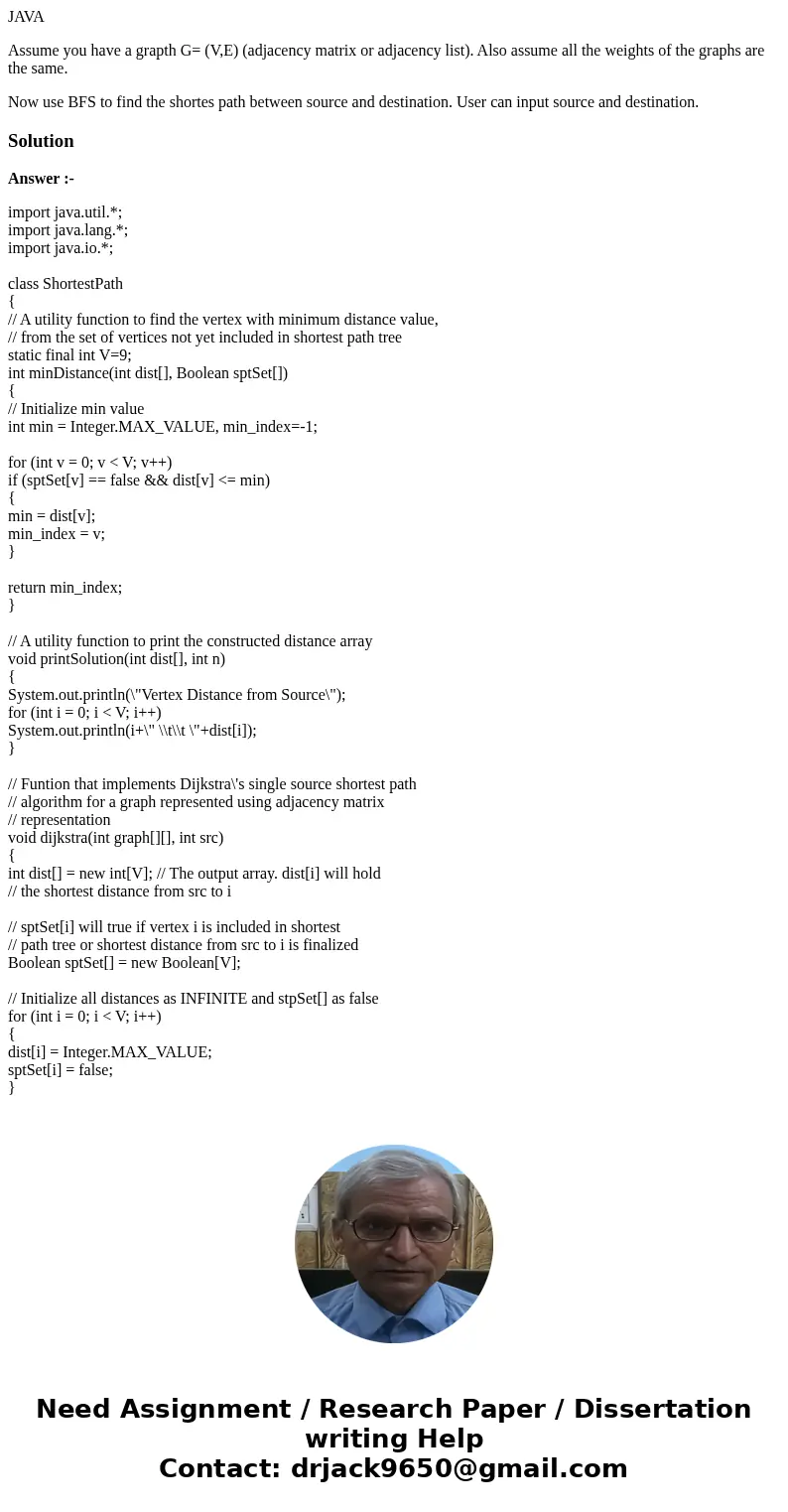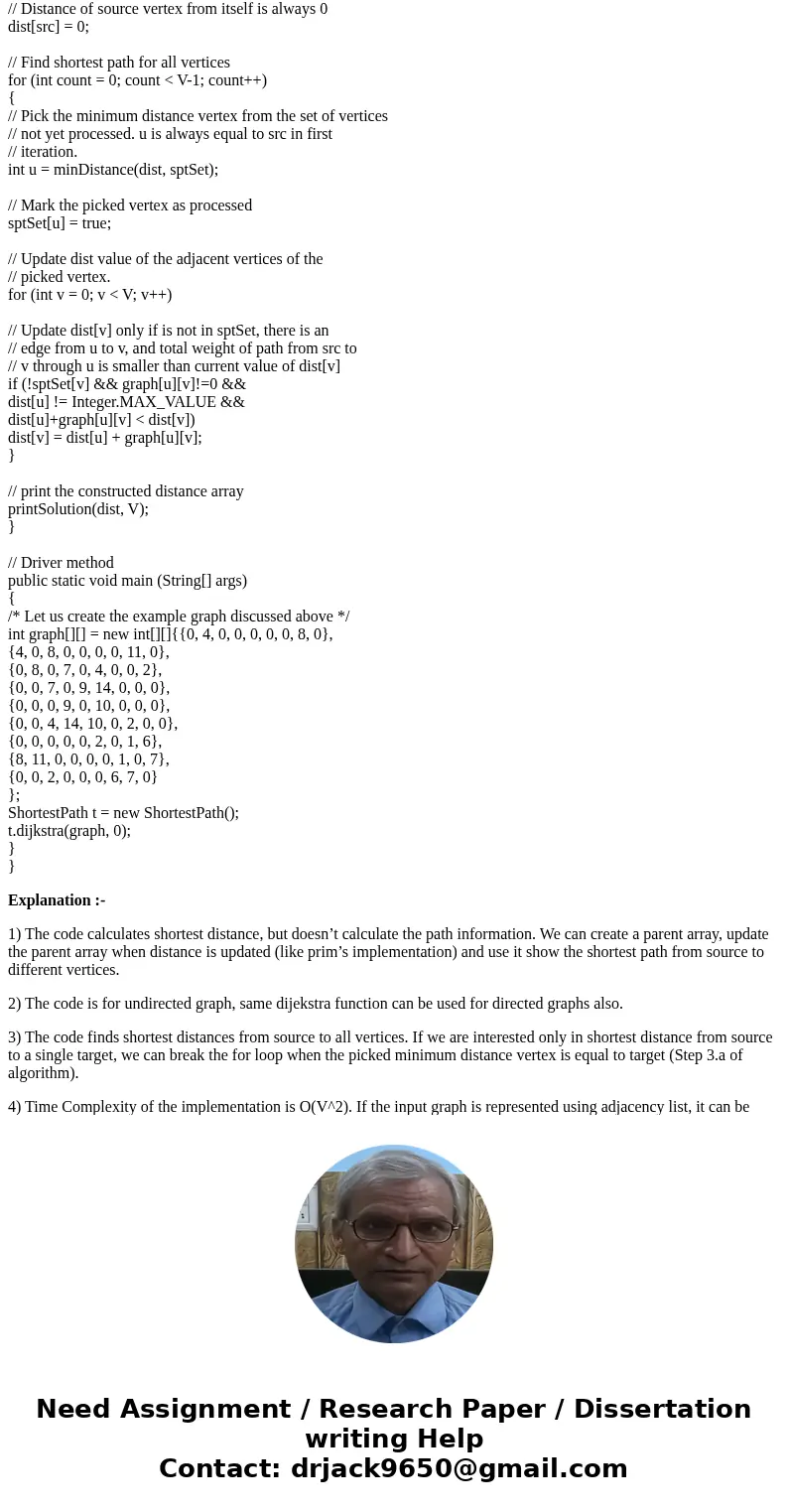JAVA Assume you have a grapth G VE adjacency matrix or adjac
JAVA
Assume you have a grapth G= (V,E) (adjacency matrix or adjacency list). Also assume all the weights of the graphs are the same.
Now use BFS to find the shortes path between source and destination. User can input source and destination.
Solution
Answer :-
import java.util.*;
import java.lang.*;
import java.io.*;
class ShortestPath
{
// A utility function to find the vertex with minimum distance value,
// from the set of vertices not yet included in shortest path tree
static final int V=9;
int minDistance(int dist[], Boolean sptSet[])
{
// Initialize min value
int min = Integer.MAX_VALUE, min_index=-1;
for (int v = 0; v < V; v++)
if (sptSet[v] == false && dist[v] <= min)
{
min = dist[v];
min_index = v;
}
return min_index;
}
// A utility function to print the constructed distance array
void printSolution(int dist[], int n)
{
System.out.println(\"Vertex Distance from Source\");
for (int i = 0; i < V; i++)
System.out.println(i+\" \\t\\t \"+dist[i]);
}
// Funtion that implements Dijkstra\'s single source shortest path
// algorithm for a graph represented using adjacency matrix
// representation
void dijkstra(int graph[][], int src)
{
int dist[] = new int[V]; // The output array. dist[i] will hold
// the shortest distance from src to i
// sptSet[i] will true if vertex i is included in shortest
// path tree or shortest distance from src to i is finalized
Boolean sptSet[] = new Boolean[V];
// Initialize all distances as INFINITE and stpSet[] as false
for (int i = 0; i < V; i++)
{
dist[i] = Integer.MAX_VALUE;
sptSet[i] = false;
}
// Distance of source vertex from itself is always 0
dist[src] = 0;
// Find shortest path for all vertices
for (int count = 0; count < V-1; count++)
{
// Pick the minimum distance vertex from the set of vertices
// not yet processed. u is always equal to src in first
// iteration.
int u = minDistance(dist, sptSet);
// Mark the picked vertex as processed
sptSet[u] = true;
// Update dist value of the adjacent vertices of the
// picked vertex.
for (int v = 0; v < V; v++)
// Update dist[v] only if is not in sptSet, there is an
// edge from u to v, and total weight of path from src to
// v through u is smaller than current value of dist[v]
if (!sptSet[v] && graph[u][v]!=0 &&
dist[u] != Integer.MAX_VALUE &&
dist[u]+graph[u][v] < dist[v])
dist[v] = dist[u] + graph[u][v];
}
// print the constructed distance array
printSolution(dist, V);
}
// Driver method
public static void main (String[] args)
{
/* Let us create the example graph discussed above */
int graph[][] = new int[][]{{0, 4, 0, 0, 0, 0, 0, 8, 0},
{4, 0, 8, 0, 0, 0, 0, 11, 0},
{0, 8, 0, 7, 0, 4, 0, 0, 2},
{0, 0, 7, 0, 9, 14, 0, 0, 0},
{0, 0, 0, 9, 0, 10, 0, 0, 0},
{0, 0, 4, 14, 10, 0, 2, 0, 0},
{0, 0, 0, 0, 0, 2, 0, 1, 6},
{8, 11, 0, 0, 0, 0, 1, 0, 7},
{0, 0, 2, 0, 0, 0, 6, 7, 0}
};
ShortestPath t = new ShortestPath();
t.dijkstra(graph, 0);
}
}
Explanation :-
1) The code calculates shortest distance, but doesn’t calculate the path information. We can create a parent array, update the parent array when distance is updated (like prim’s implementation) and use it show the shortest path from source to different vertices.
2) The code is for undirected graph, same dijekstra function can be used for directed graphs also.
3) The code finds shortest distances from source to all vertices. If we are interested only in shortest distance from source to a single target, we can break the for loop when the picked minimum distance vertex is equal to target (Step 3.a of algorithm).
4) Time Complexity of the implementation is O(V^2). If the input graph is represented using adjacency list, it can be reduced to O(E log V) with the help of binary heap.



 Homework Sourse
Homework Sourse